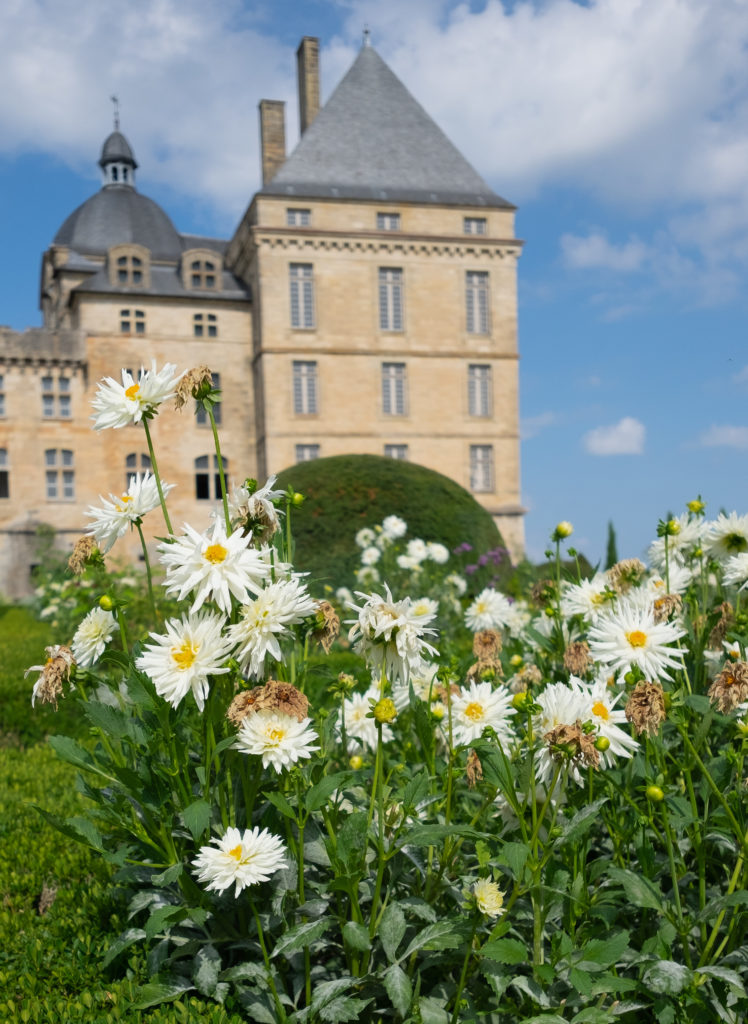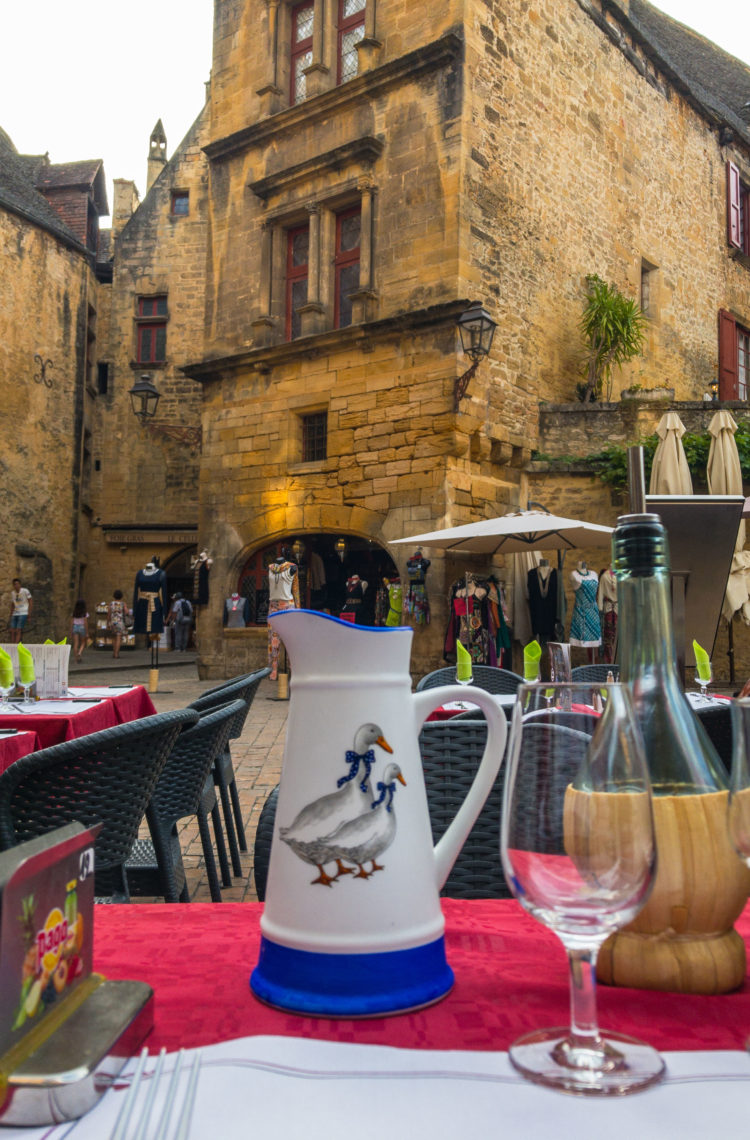Few regions in France capture the imagination quite like the Dordogne. It’s a landscape of storybook villages, stone castles, and lush river valleys—where the past feels close enough to touch. There are a thousand places to see here, but there’s no better place to start than Sarlat-le-Canéda, the vibrant capital of the Périgord Noir. From there, you can easily reach some of the country’s most beautiful and historic sites, including the mighty fortress of Beynac, the elegant Château de Hautefort, and the perfectly preserved bastide town of Monpazier.
Market Day in Sarlat-le-Canéda: The Beating Heart of the Périgord Noir
I’ve written elsewhere about all the reasons why it’s a great idea to visit Sarlat-le-Canéda, the perfectly preserved medieval town in the heart of the Périgord Noir. It’s one of France’s most popular destinations—last time I was there, I heard more British accents than French—and within half an hour of some of France’s most fascinating historic sites: castles, prehistoric cave paintings, and troglodyte dwellings. It’s also a paradise for cycling, canoeing, hiking, or simply exploring the Dordogne River valley. In every way that matters to a traveler, Sarlat earns the rare 3-star rating that it holds in the Michelin Green Guide.
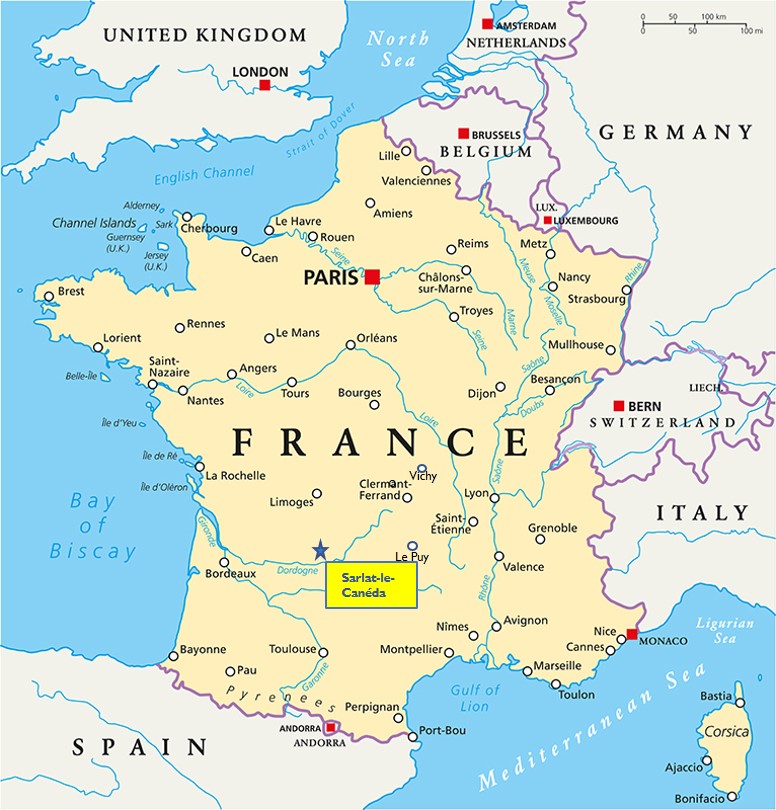
At the center of the action in Sarlat
On one recent visit, I rented an apartment perfectly situated on top of a café overlooking the town’s great Place du Marché. I awoke early on a Saturday morning, and like most Saturday mornings for hundreds of years, it was market day in Sarlat. The banging and shouting begin just after 4:00 a.m. as the first trucks arrive in the space and merchants begin reconstructing their booths and awnings for the long day ahead.
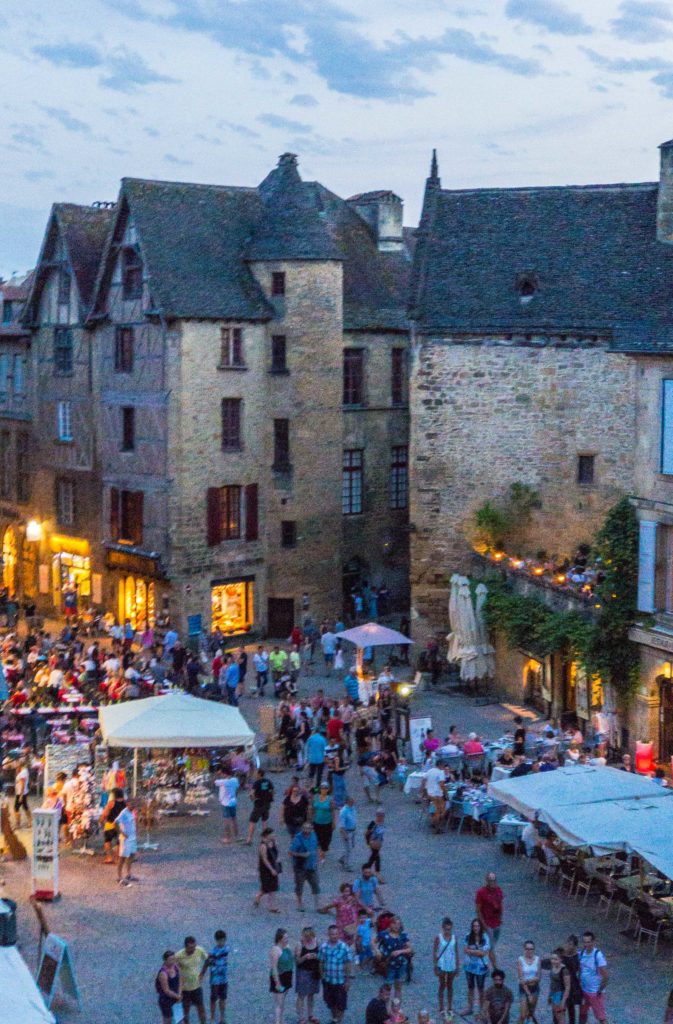
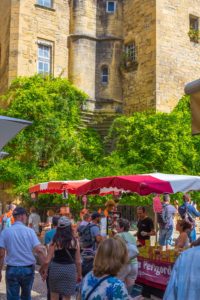
(One of the things that strikes me about every market in France is how much labor these merchants must invest as they move from town to town, installing their equipment, unloading their wares, staffing the booth all day, keeping an eye on the passing crowds as they try to talk to a specific customer, then tearing everything down, cleaning up, reloading, and moving on to some other town to repeat the whole process in a day or two!)
By 7:00, the market is open for business, baskets overflowing with mushrooms, honey, and cheeses; sausages and truffles scenting the air. The first customers start to walk slowly through the Place while the produce is still at its freshest, while the baguettes are still warm. By noon the crowd in the narrow streets will be shoulder-to-shoulder and there’s no way to hurry through; that will last until around 6:00 p.m., when the stalls start to close and the crowd begins to scatter into the bars and restaurants around town.
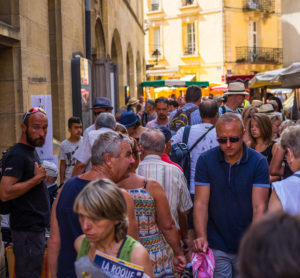
(Here's a video that will give you an idea of the work that goes into setting up the market and a flavor of life in Sarlat on market days.)


An 800-year-old tradition
I think the thing that pleases me most, personally, about markets like this is knowing that people have been doing this work, engaging in this kind of commerce, for hundreds and hundreds of years. They came when the Hundred Years’ War and the Wars of Religion ravaged this part of France; they came when Revolutionary fever swept through the country, and they came even in years when crops failed and the food they had to sell was poor and scarce.
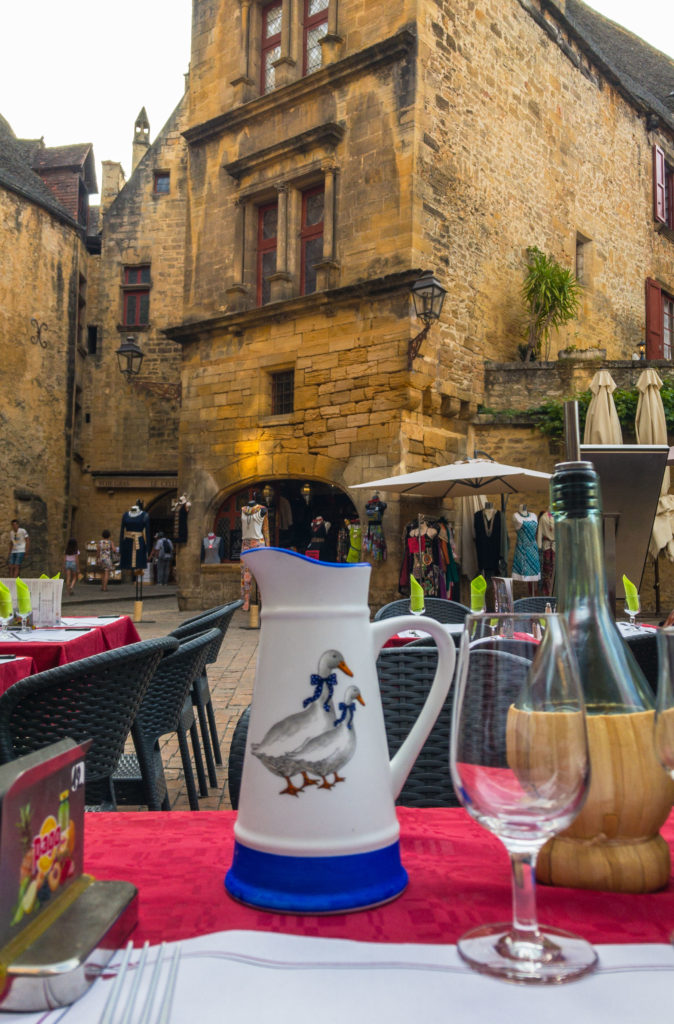
That sense of history is present in a few other markets we’ve visited around France – I’m thinking particularly of the fine smaller market in Vienne, south of Lyon, which can also trace its roots to the Middle Ages – but it’s heightened in Sarlat because of the setting itself. This town is almost perfectly preserved as it would have looked in the 14th century; all the buildings in the center have authentic roots in the Middle Ages and the Renaissance. It’s so authentic, in fact, that it shows up regularly in movies like The Musketeer (2001) and Luc Besson’s 1999 biography of Joan of Arc, The Messenger.
A Feast for the Senses
So there’s plenty to see in Sarlat even if you don’t come on market day. But if you can plan to be in town on a Saturday, what riches you’ll find!
There are enormous steaming skillets of paella if you just want something to eat right now…
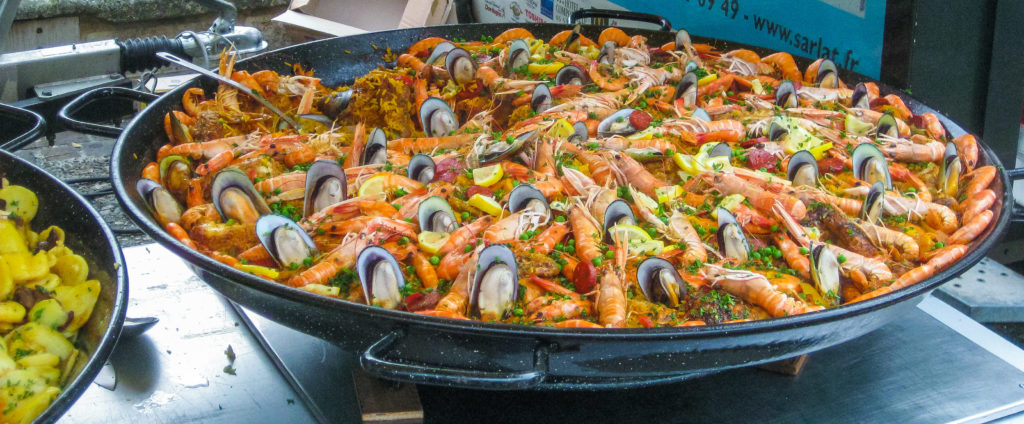
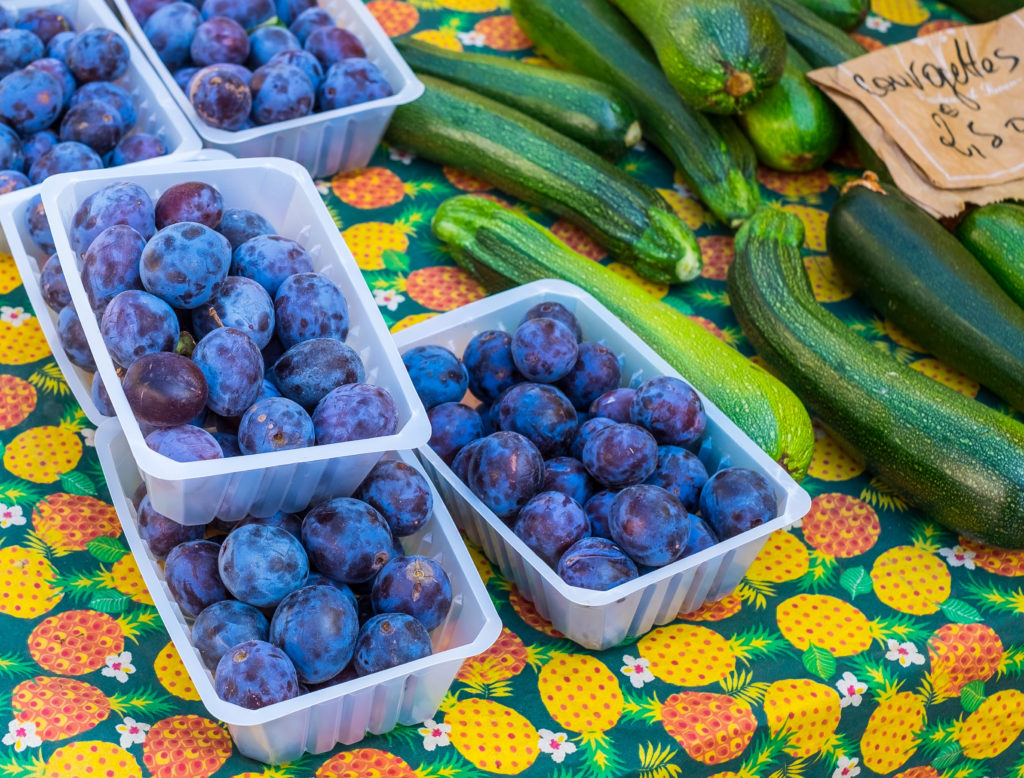
Grapes the size of golf balls…
Peppers in more colors than I knew existed…
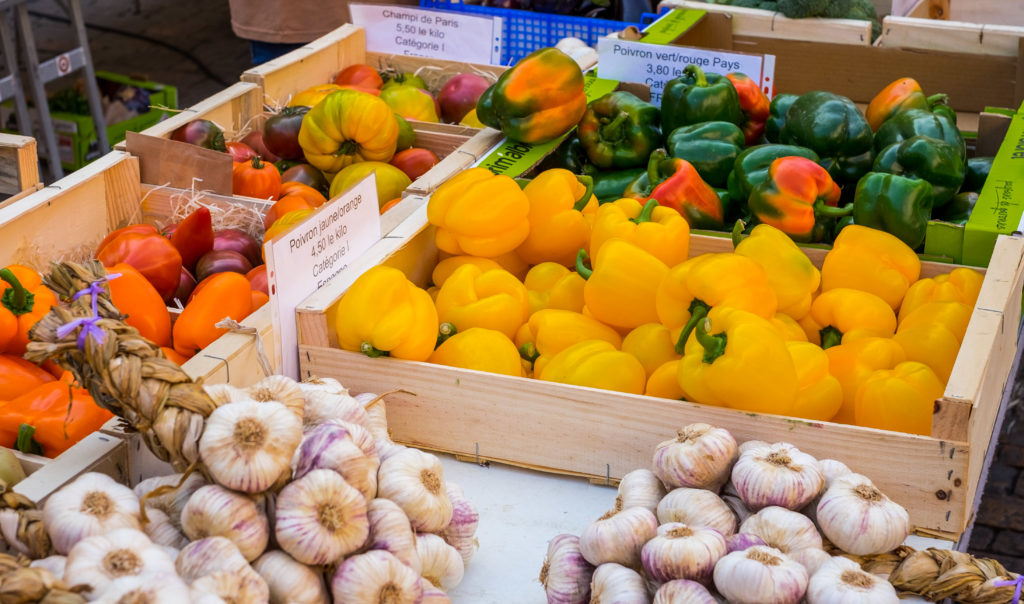
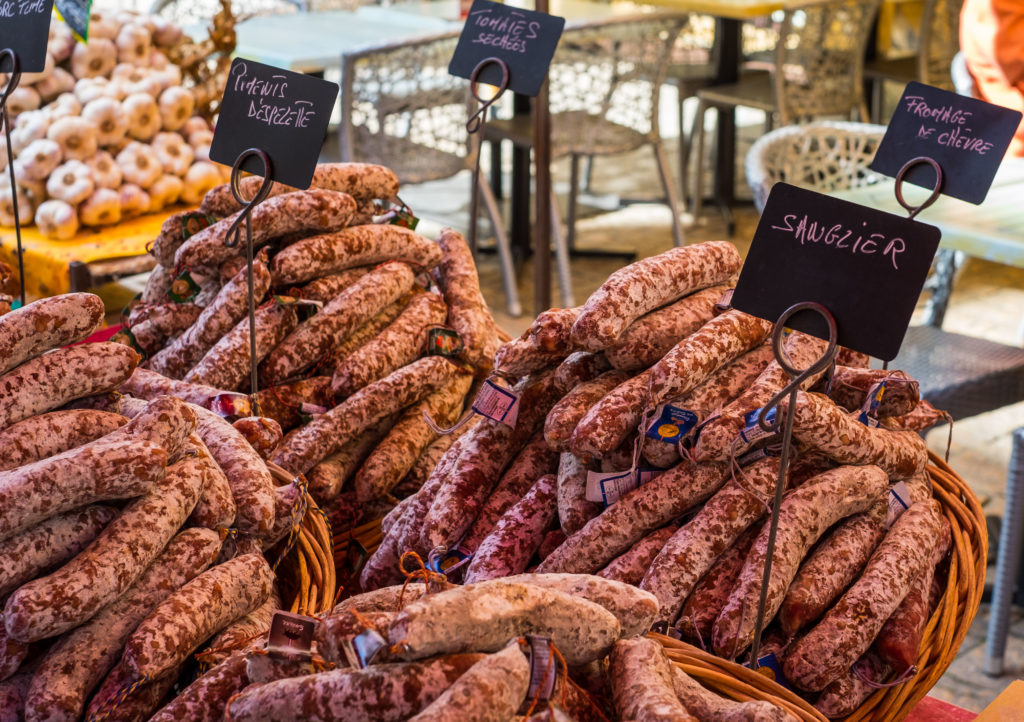
Earthy, rich sausages made from any meat you can imagine (that’s sanglier – wild boar – sausage in the foreground) …
Fresh fish…

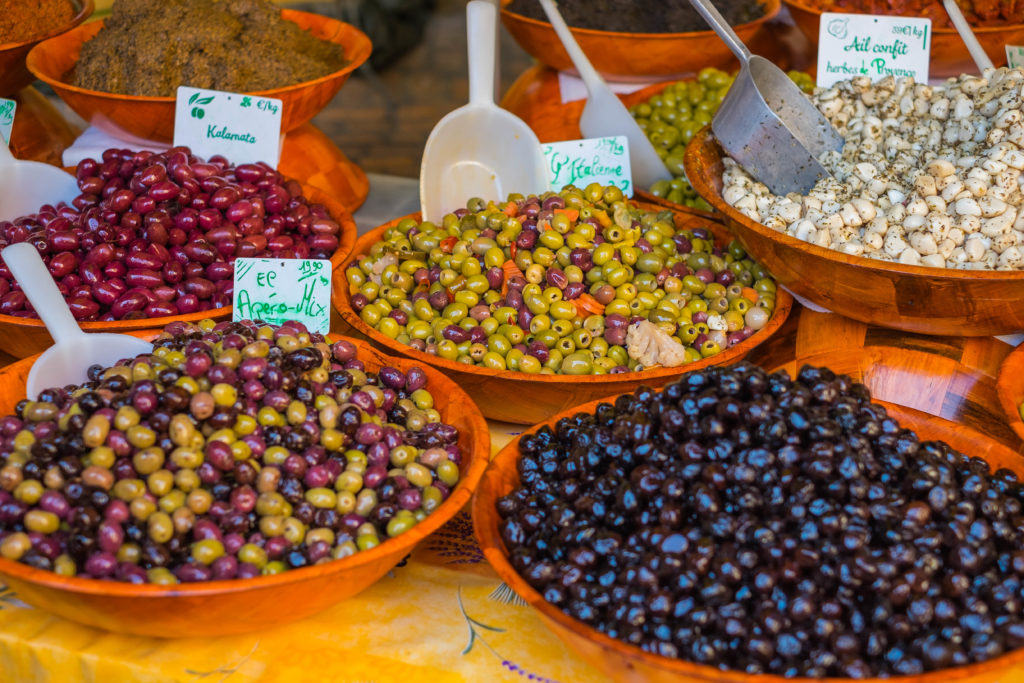
Cocktail olives in a variety of flavors…
Spices in bulk, the way they might have been presented at a street market just off the ship from India or China in centuries past…
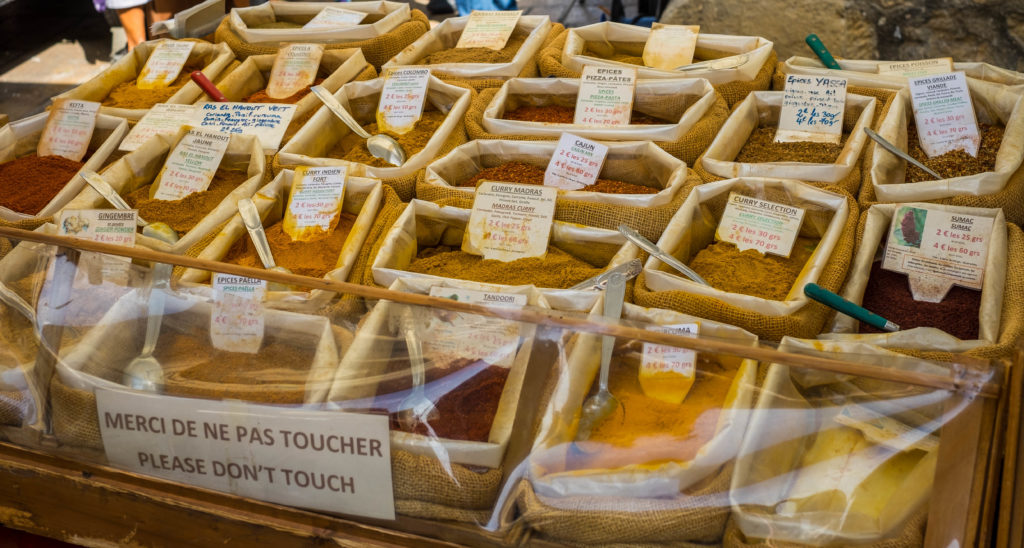
An ancient church transformed into a gourmet temple
But if you want to really go “local” while you’re here, this region is famous everywhere in the world for two of its gourmet specialties: truffles and “anything related to a duck”. These are available from many of the vendors in the street market, but to find the best suppliers I recommend you step inside the covered market set up in an old church. The Eglise Saint Marie, originally built in the 12th century and reconstructed in the 14th and 15th, was deconsecrated and trashed during the French Revolution and turned into a weapons factory and then a post office and a clinic.
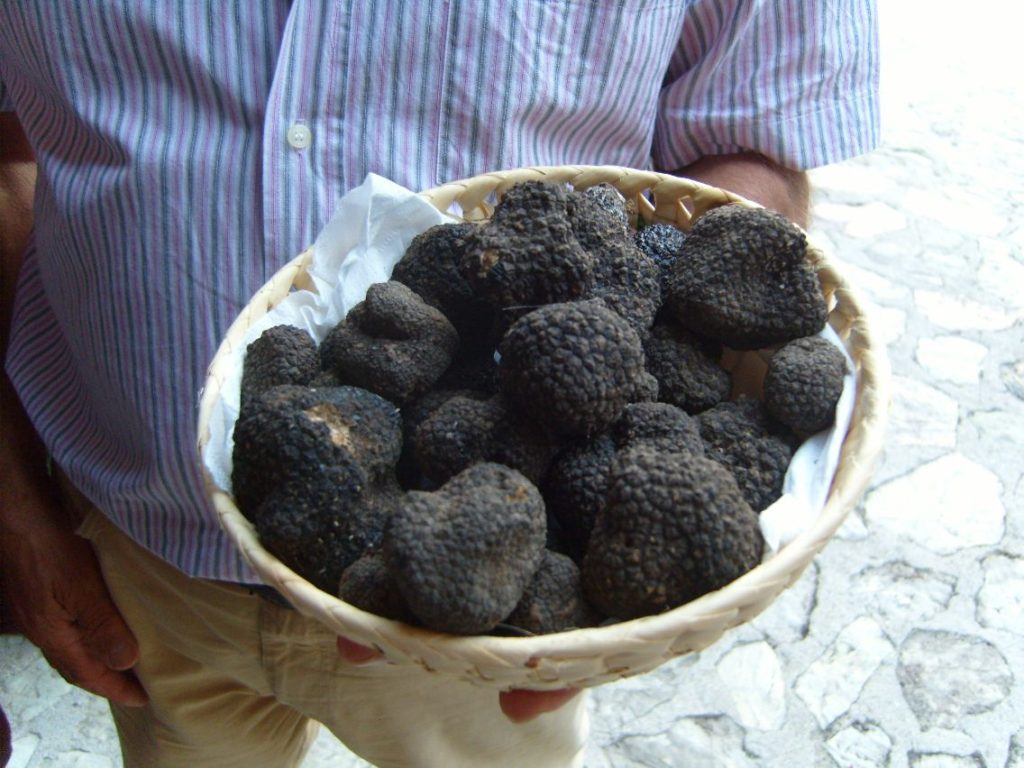

The old church was rescued in 2000, and the covered market inside is actually open every day of the week from mid-April to the end of October. This is where you’ll find the good stuff – meaty black truffles, whole ducks and any individual part of a duck you can imagine eating, and of course, foie gras in dozens of forms. Even if you don’t want (or can’t afford) any of the pricey gourmet treats, you might still visit here and take the glass-walled “observation” elevator that’s been built into the old church’s bell tower for a spectacular view of Sarlat and the surrounding countryside. As the sun sets and the market stalls close, the light softens across the Renaissance façades, and it’s easy to see why people have gathered in this square for hundreds of years. Sarlat is not just a town; it’s a living tradition.
Beynac: A Mighty Fortress Over the Dordogne
Once you’ve taken in all the pleasures of a market day in Sarlat, it’s only a short 15-minute drive to Beynac-et-Cazenac, officially one of France’s “Most Beautiful Villages”.
There are thousands of castles in France. Most of them are very small, the medieval homes of some minor aristocrats, or buildings meant to protect travelers along a stretch of a specific route. At the high end of the range, you know some of the others already – the great, graceful palaces like Chambord and Chenonceau in the Loire Valley that retained some of their defensive structures but that obviously focused more on the royal luxury of the kings and queens who lived there.
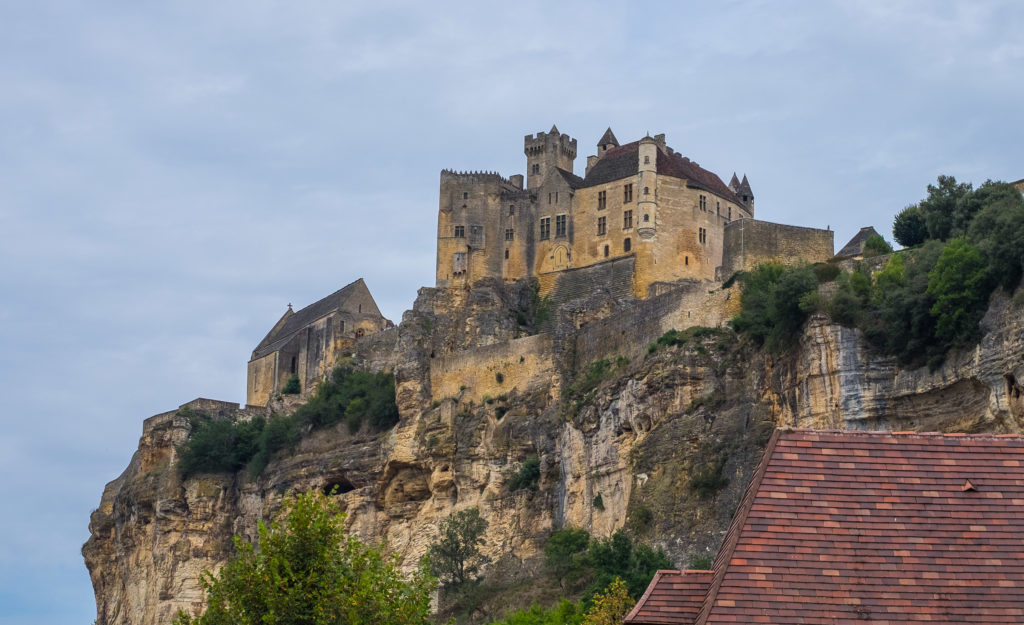
There’s another category of castle, though: the ones that clearly meant business, fortresses created mainly for serious military action, small towns hardened for war. One of these mighty fortresses dominates the rocky bluff over Beynac in the Dordogne. As a bonus? The village surrounding it is also on the official list of “Most Beautiful Villages in France.” (Its official name is Beynac-et-Cazenac because the village merged with the commune of Cazenac in 1827 – but, really, Beynac is the main attraction and even the town’s official website refers to it simply as “Beynac”.)
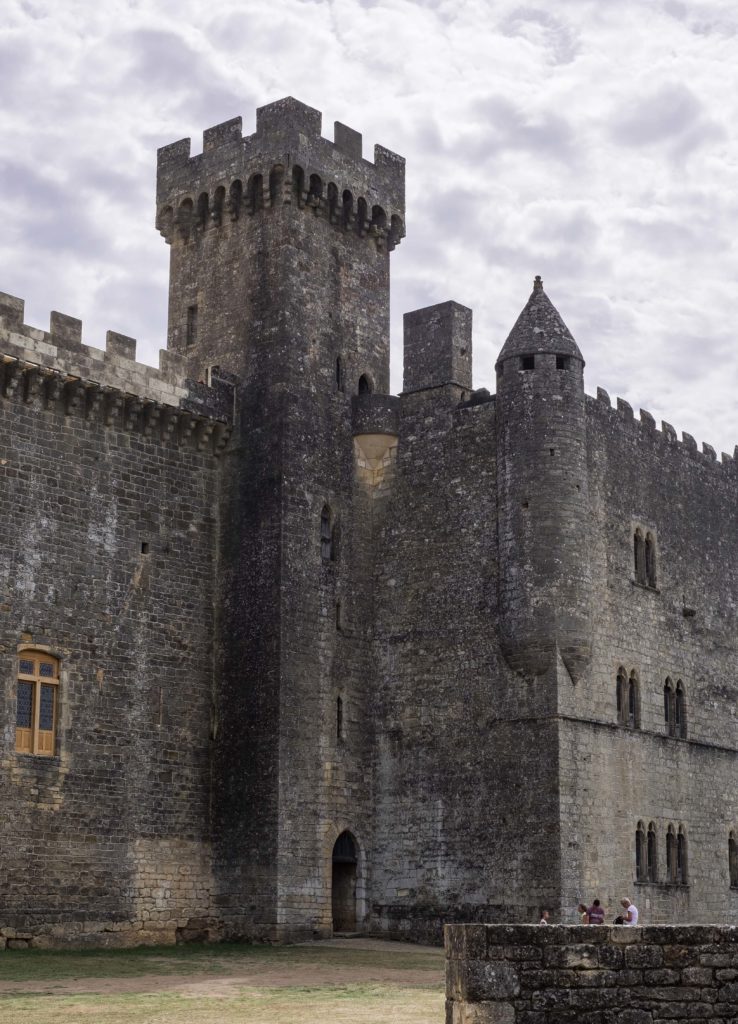
You’ll know as soon as you see it on the horizon that the chateau at Beynac must be a big deal – it’s even featured in one of the travel videos produced by Rick Steves. It’s an incredibly popular tourist site. The village is layered up and down the side of the hill, beginning along a narrow 2-lane road at the level of the Dordogne River.
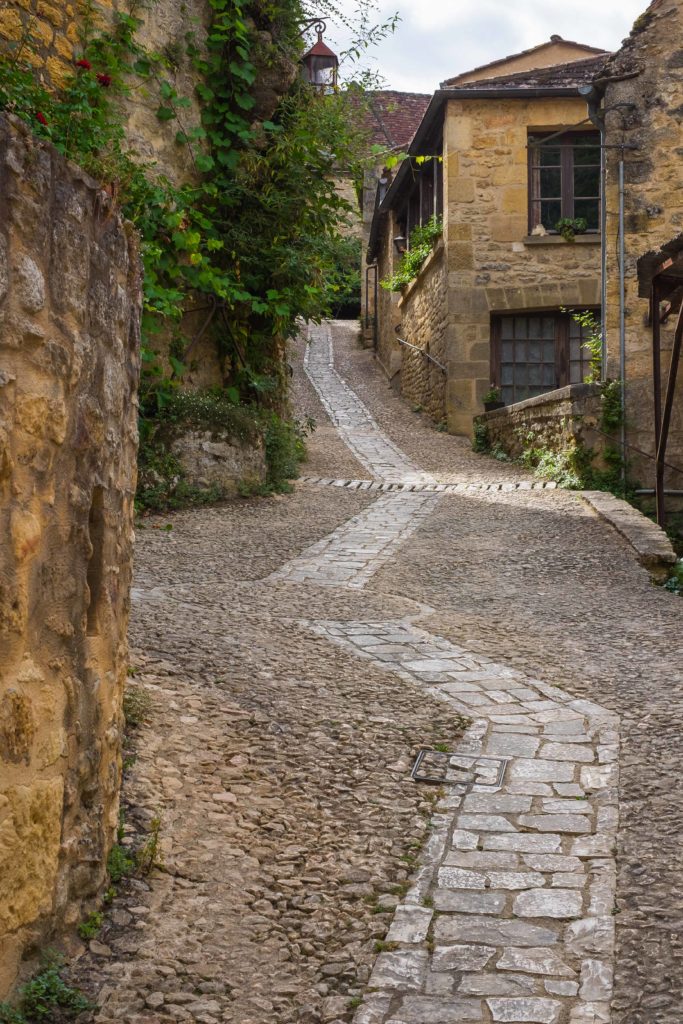
Arriving in Beynac means parking down by the river and climbing up to the castle. These are narrow cobblestone streets, and in many places the stone steps are worn down; it’s sometimes difficult to find your footing. And the climb is steep! Fortunately, there are a couple of small restaurants on the way up if you need to stop to catch your breath and have a coffee.
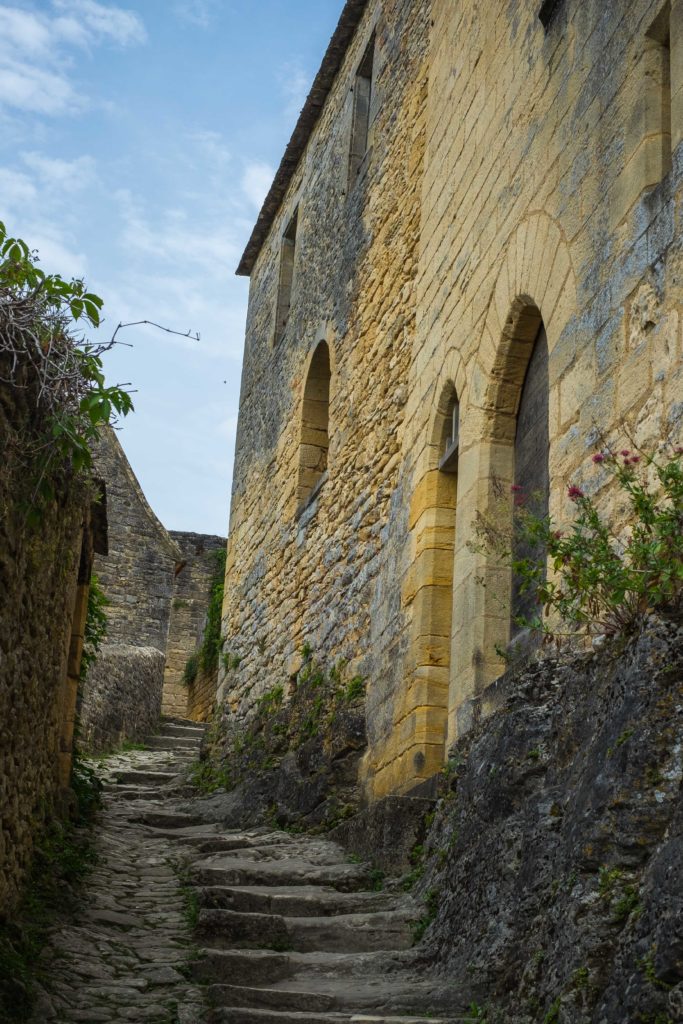
In the footsteps of Richard the Lionheart
The first known Baron of Beynac built a castrum here around 1050 A.D.; the first part of the existing chateau (built in the 1100s) was the keep, the great tower rising in the middle of the site. From this height, the first lords of Beynac could see up and down the Dordogne and the roads crossing it for miles; that visibility alone was a source of power for these first barons, since it gave them the ability to sell protection, tax commerce, and protect their properties.
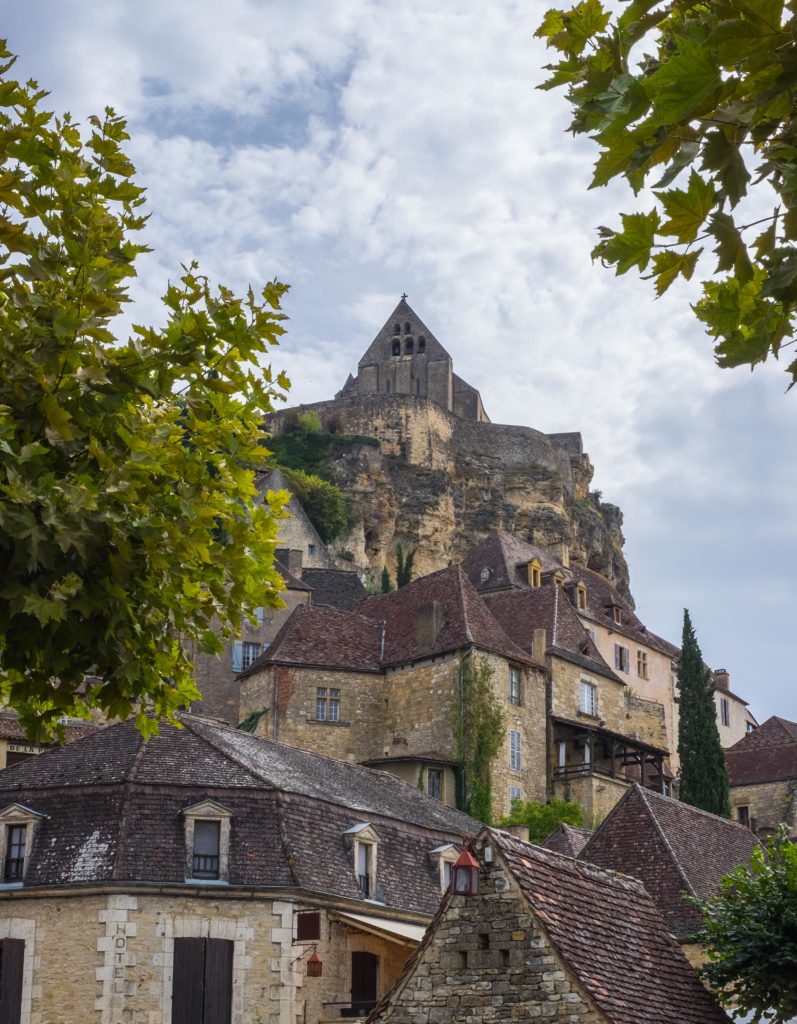
Then the wars came, and they came in waves. Over the centuries, Beynac saw an unending cycle of conflict and conquest—Richard the Lionheart seized it for England in 1189, only for it to be reclaimed by French forces after his death. Later, it became entangled in the Hundred Years’ War, changing hands repeatedly between the English Plantagenets and the French Valois.
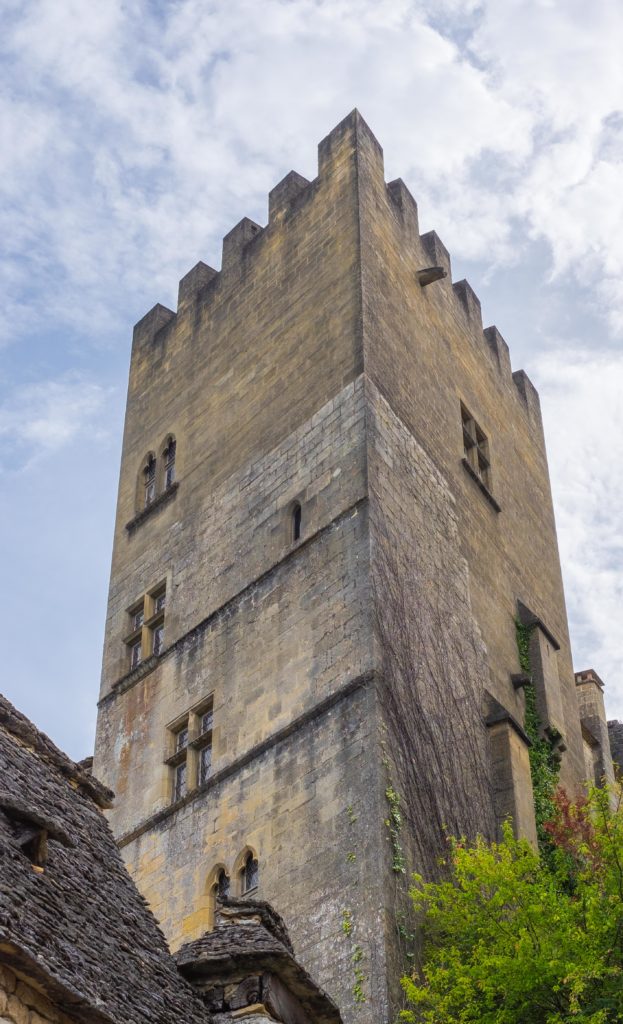
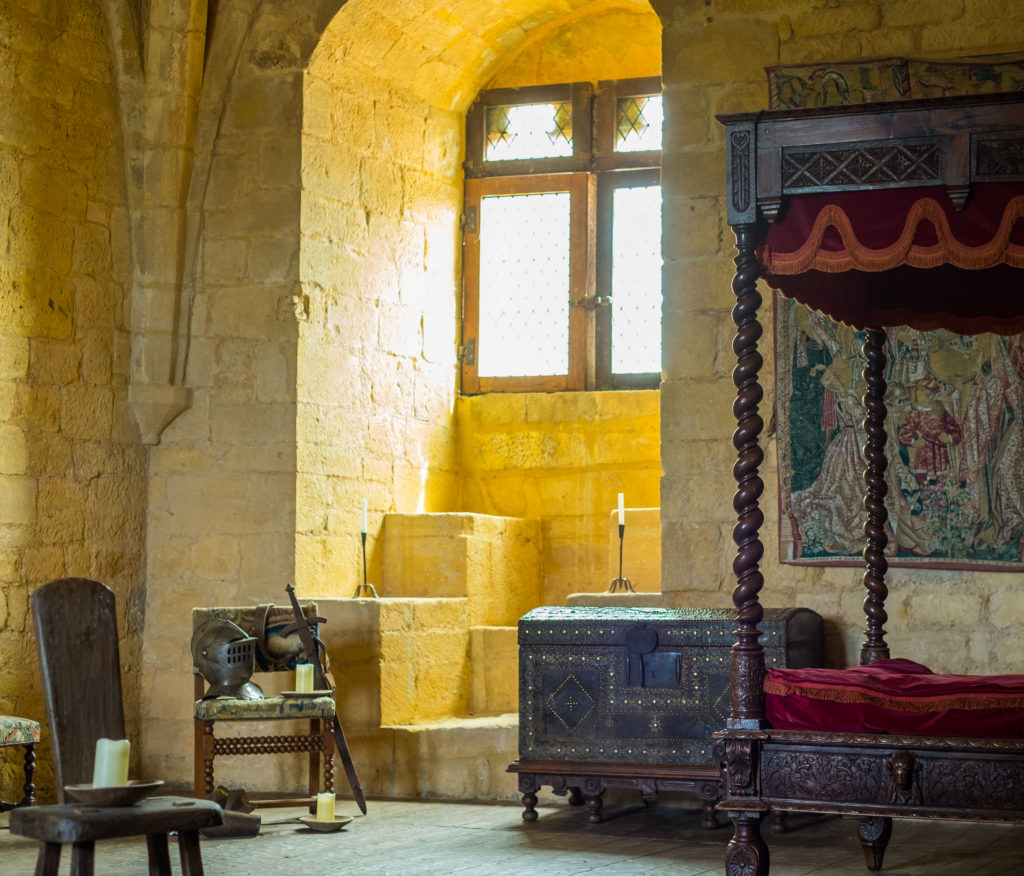
Rick Steves says it more succinctly in his video about the castle. Standing in a doorway overlooking the courtyard at Beynac, he says, the lord of the manor would announce to his people
“Now you are French,” or “Now you are English – in any case, deal with it!”
(If you want an idea about how ugly and traumatic this war might have been, be sure to drive across the valley from Beynac to visit another of France’s “most beautiful villages” at Castelnaud-la-Chapelle. These two massive blocks of military might regularly faced off against each other during this period; Castelnaud has an extraordinary “Museum of Medieval Warfare” within its walls, complete with every variety of gun, sword, crossbow, and siege engine you can imagine. I highly recommend a visit!)
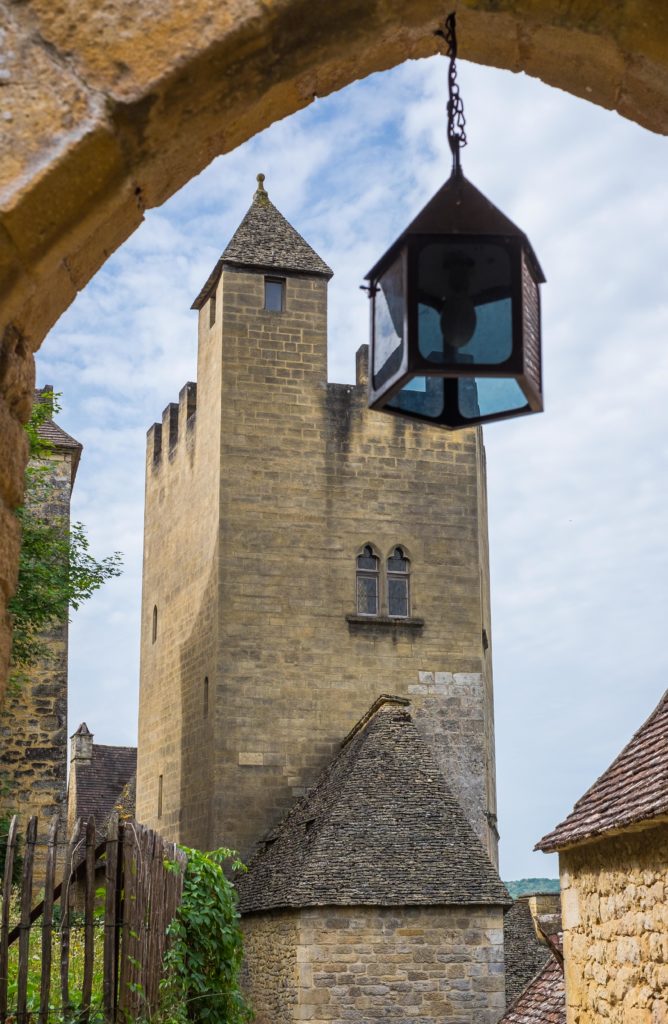
Despite centuries of siege and strife, Beynac remained in the same family until 1962. Its stone halls, great chamber, and Renaissance additions still evoke the blend of austerity and grandeur that defined France’s medieval nobility. Like Sarlat, it’s a place where the centuries seem to echo around every corner.
Hautefort: From Fortress to Renaissance Splendor
If Beynac represents the martial side of the Dordogne, Hautefort embodies its refinement. Rising gracefully from a hilltop northeast of Sarlat, the Château de Hautefort might first remind you of the grand palaces of the Loire Valley—but its roots are much older. The current structure stands on the foundations of a thousand-year-old fortress, and some of its medieval defenses still remain.
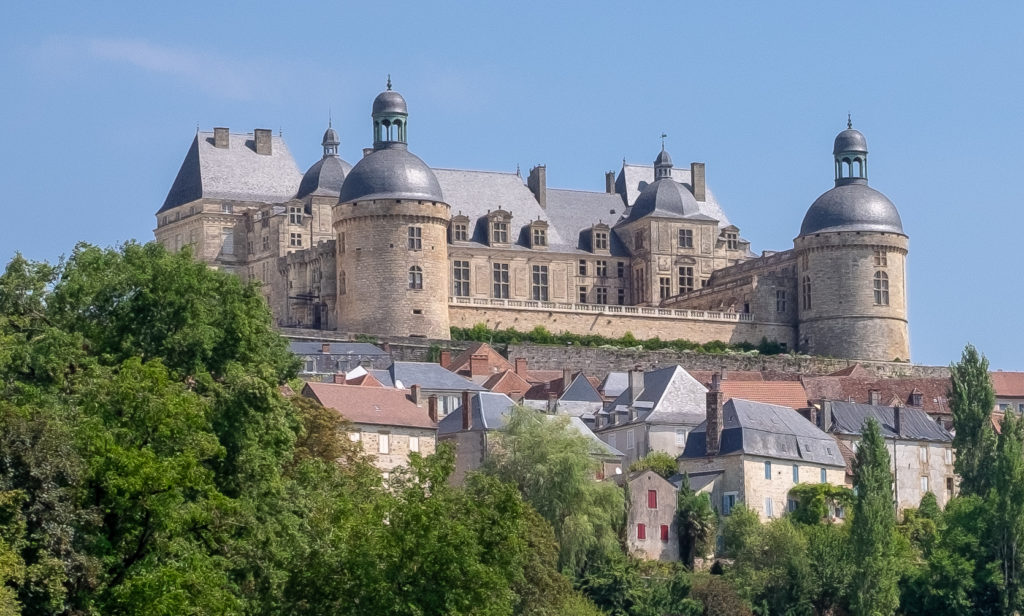
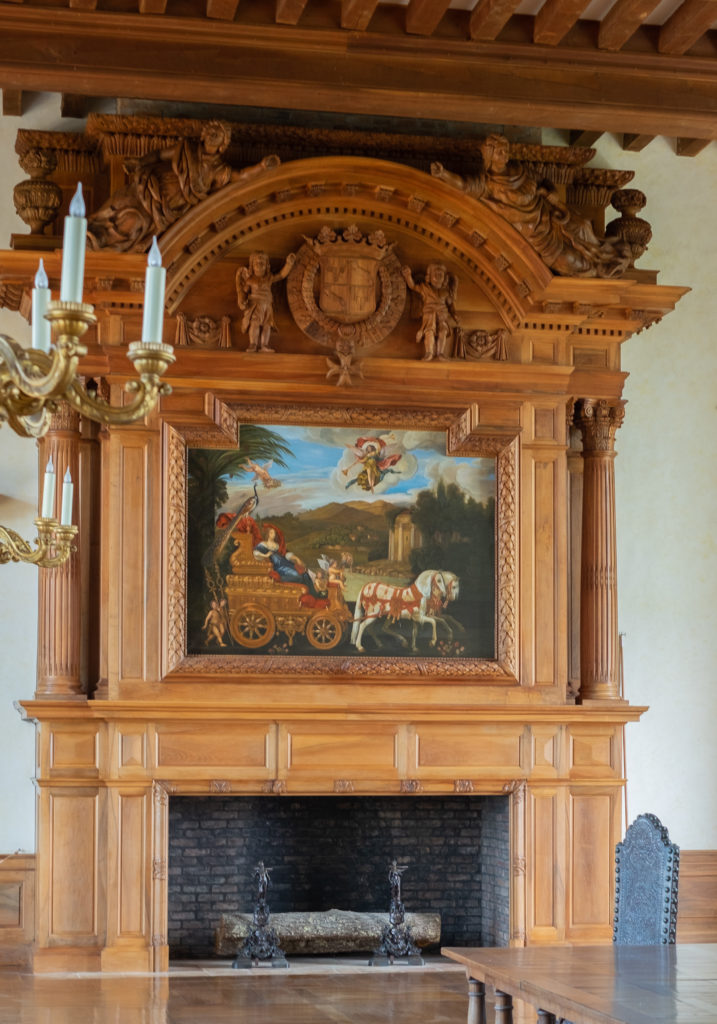
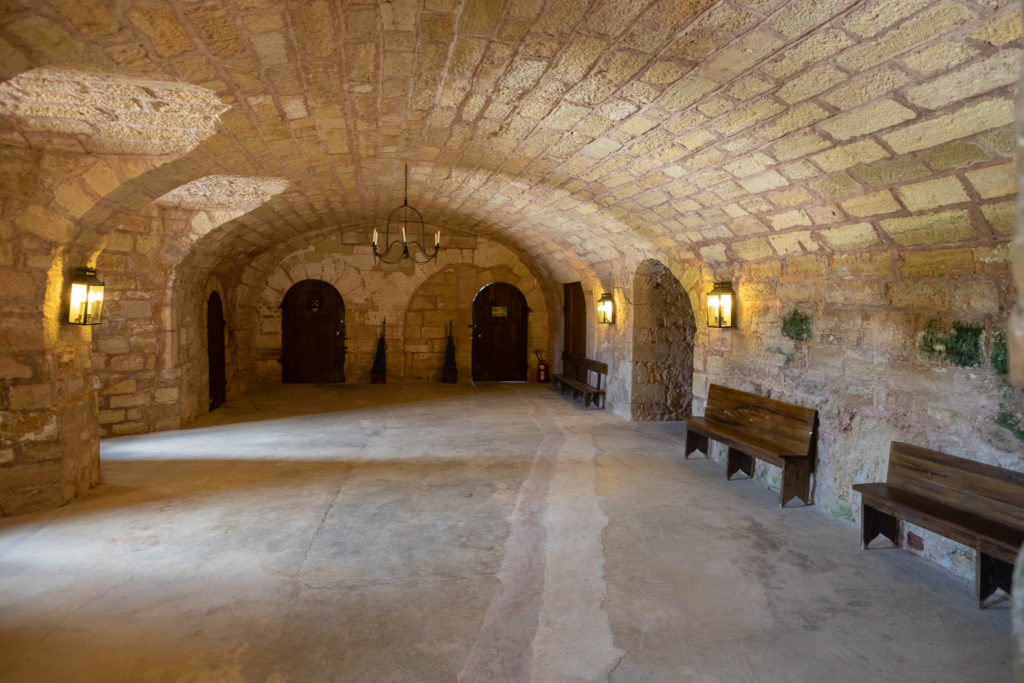
In the 17th century, the estate was transformed into an elegant classical residence when its owners were elevated to the rank of marquis. Under master architects, the interiors bloomed with carved mantles, Aubusson tapestries, and polished parquet floors. Beneath the beauty lies an extensive network of tunnels and storerooms that once supported the castle’s daily life.
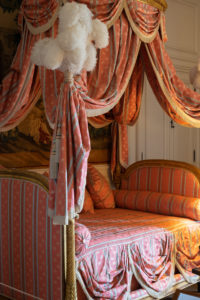
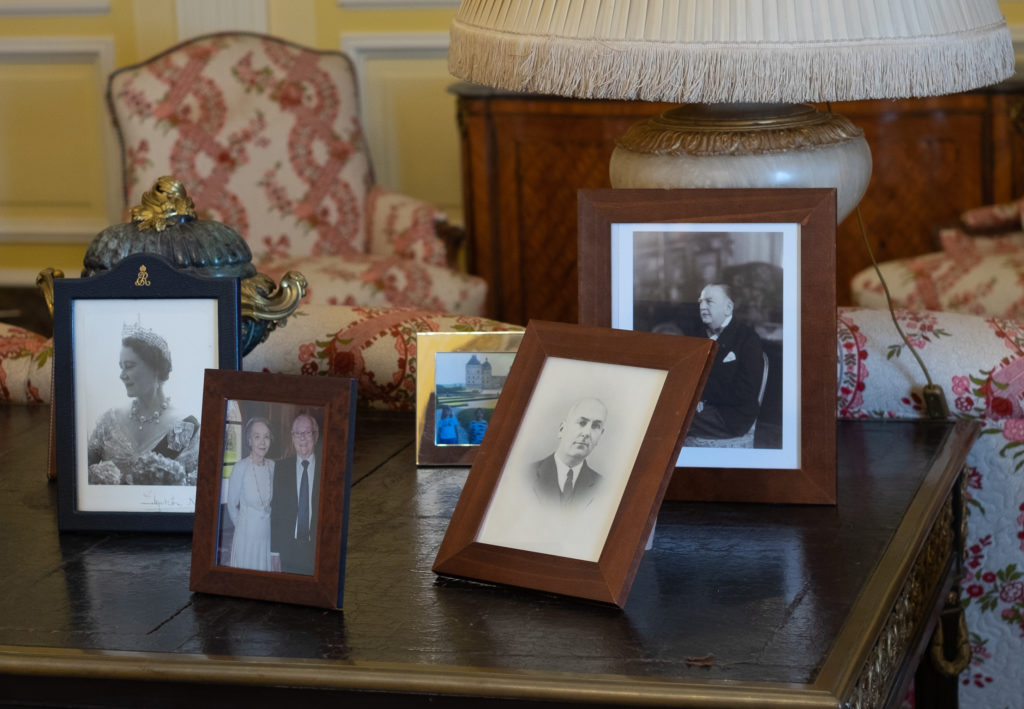
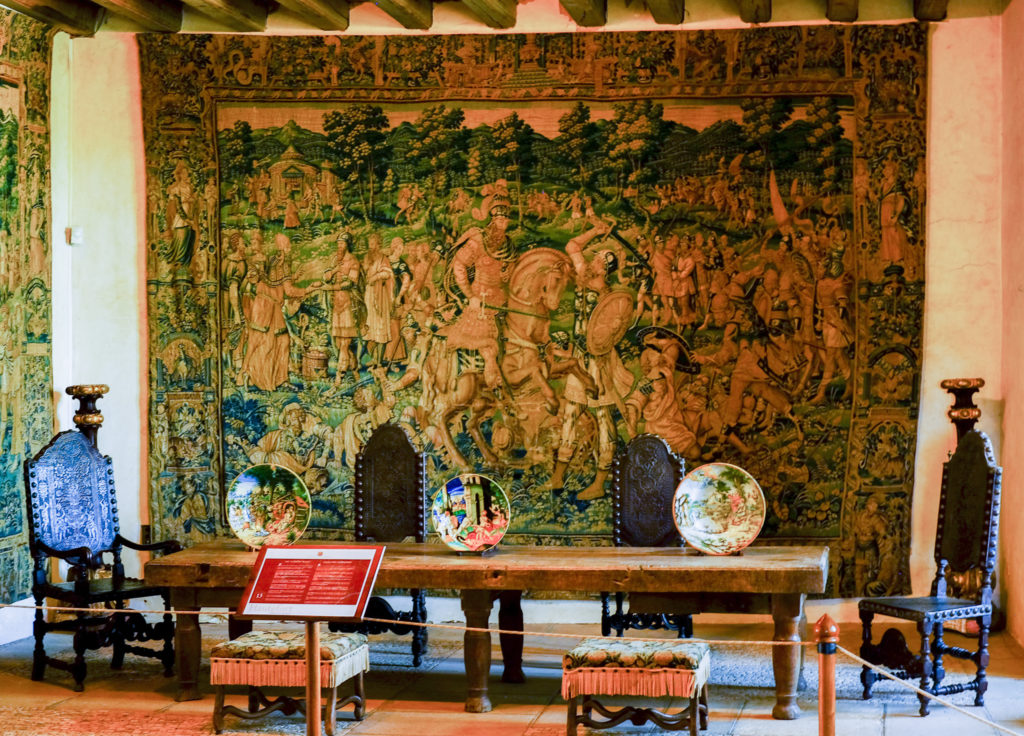
A Castle with a Conscience
Unlike many nobles of his day, Jacques-François de Hautefort, who ruled from 1640 to 1680 and was largely responsible for the castle’s transformation, was beloved by his people. He built a hospital for the poor -- now home to a fascinating Medical Museum in the village below the castle -- and his family’s generosity was repaid generations later. When an army of the French Revolution came to destroy Hautefort in 1792, the people of the village “melted their copper pots and turned them into arms” to stand up in defense of the chateau!
By the early 20th century, however, the château had fallen into ruin. Salvation came in 1929 when the Baron and Baroness de Bastard purchased and painstakingly restored it—only to see it gutted by fire in 1968. Undeterred, the Baroness dedicated the rest of her life and fortune to its reconstruction. Thanks to her persistence -- and national support-- the château stands today in dazzling condition.
Visiting Hautefort Today
The formal gardens, designed in the 19th century and restored by hand twice a year, are among the finest in France. Inside, the rooms feel both stately and lived-in, with family photographs and fine period furnishings.
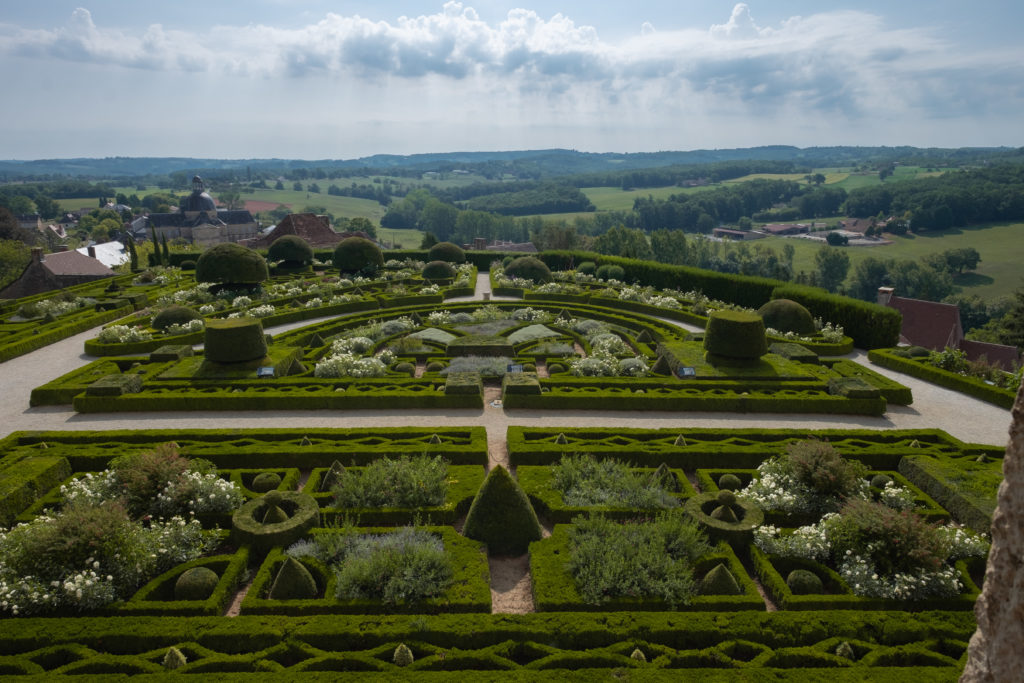
The château’s elegance has made it a favorite film location—most famously in Drew Barrymore’s remake of the Cinderella story, Ever After (1998). It’s often used in films and TV shows as a stand-in for the more famous châteaux of the Loire Valley.
It’s an easy day trip from Sarlat, and together with nearby attractions like the Gardens of Marqueyssac, Hautefort offers a perfect glimpse into the region’s blend of history, artistry, and resilience.
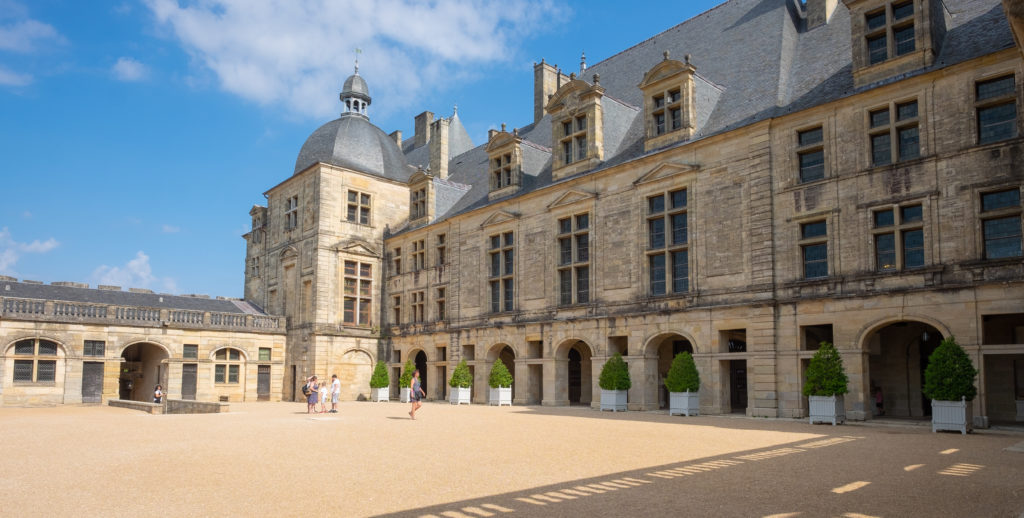
Monpazier: A Perfect Bastide and a Living Medieval Legacy
Traveling southwest from Sarlat, the landscape opens into gentle farmland and low wooded hills—until you arrive at Monpazier, another of France’s “Most Beautiful Villages.” Founded by England’s Edward I in 1284, Monpazier is one of the best-preserved examples of a bastide, or planned medieval town. (The formal definition of a bastide is “any town planned and built as a single unit, by a single founder”.)
Try conjuring up a time when threats were so immediate, so constant that everything about your little town was built to ward off the danger, even in remote regions far from the population centers in Paris or Lyon. A product of the horrific Hundred Years’ War (1337 to 1453), Monpazier transports us back to such a time.
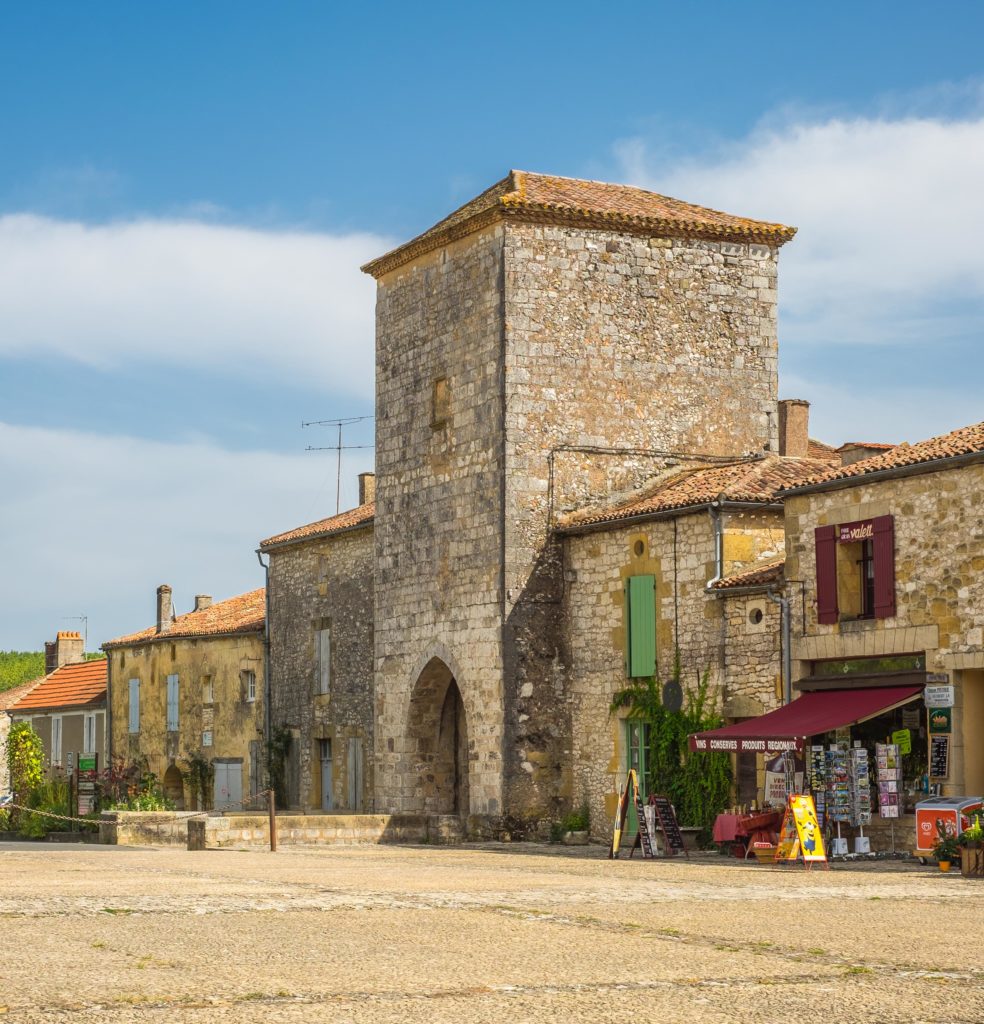
Towns like Monpazier became essential refuges for the people living around them. Imagine working in the fields and hearing the distant, urgent ringing of church bells that signaled a fresh invasion on the way. Imagine the mad scramble to safety, the push to get inside the city walls in time. And imagine the stress and anxiety you might feel in the face of a more or less permanent threat stretching across all the decades of your life. One day your king was French; the next English; then the cycle repeated.

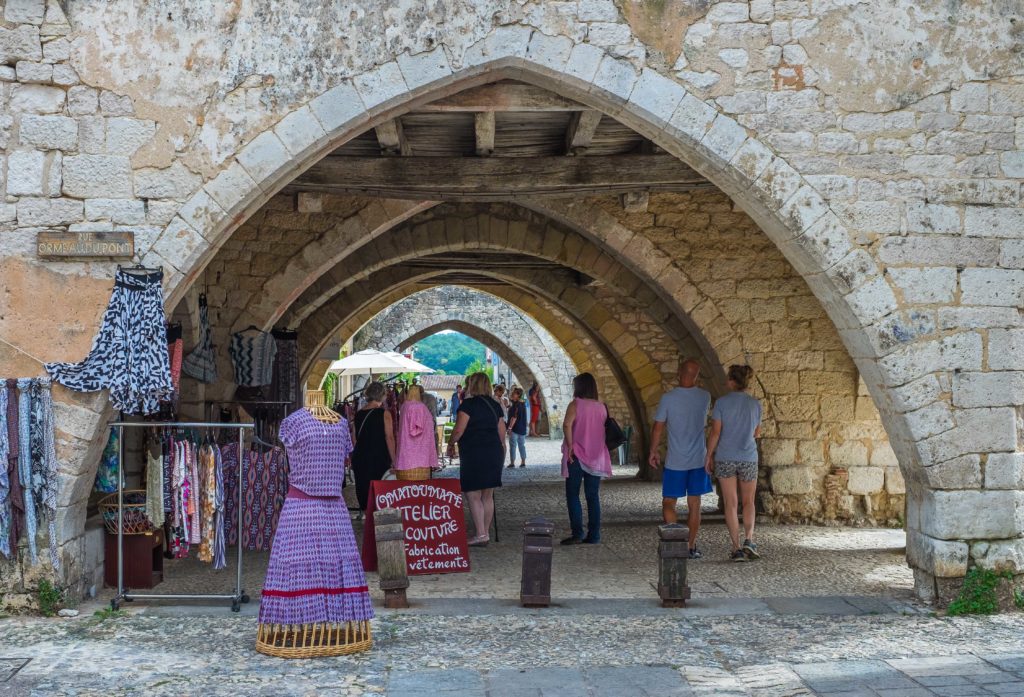
As part of its defensive walls, the bastide originally had seven great gates controlling access to Monpazier. Only three remain, but they’re massive and impressive. The gatehouses in the original walls were meant to be left open most of the time, but with mechanisms for closing the massive doors and dropping a heavy grate in front of them.
A Peaceful Town with a Storied Past
The atmosphere these days is definitely more “artisan” than “military”, with many small galleries and elegant shops displaying local crafts along the boulevards and around the central plaza. The fine old houses that surround the square were all built with arcades in front, so you can make the complete tour with only an occasional step out into the sunshine or the rain.
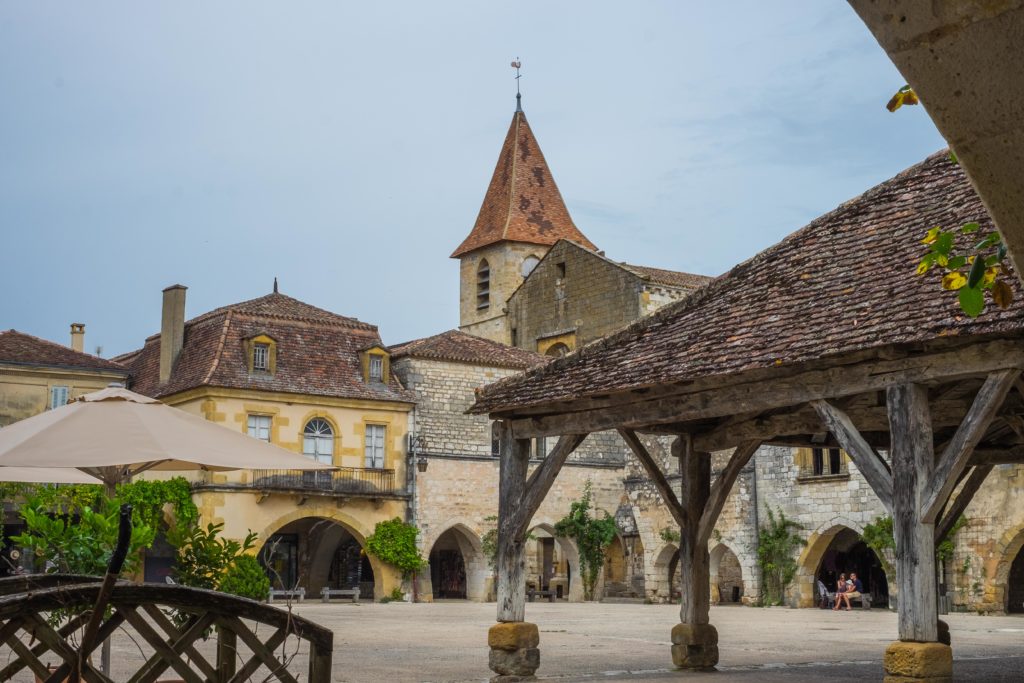
It’s not a very large village – no more than 600 residents – so it’s easy to cover all the highlights in a visit of a 3 or 4 hours. Take a slow walk around the arcades or pause in the sunlight at the center of the square. Close your eyes and imagine the clang of the town gates, the peal of warning bells, the rush of people seeking safety within the walls. Then open your eyes again to see a tranquil, thriving community that has turned its long, difficult history into quiet beauty.
A Journey Through Time in the Dordogne
From the bustling markets of Sarlat to the soaring battlements of Beynac, the elegance of Hautefort, and the perfect geometry of Monpazier, the Dordogne is a living museum of French history. Each place tells a different chapter of the same long story—a story of resilience, artistry, and human endurance.
Come for the food and the scenery, but stay for the sense of time that lingers here. In the deep heart of France, the past is not forgotten—it’s part of the landscape itself!
Have you visited a place in France where you felt particularly close to the past? Or where the connection between past and present seemed particularly vivid to you? Please tell us about it in the comments section below. And please take a second to share this post with someone else who’s interested in traveling in (or knowing more about) the “deep heart” of France.
